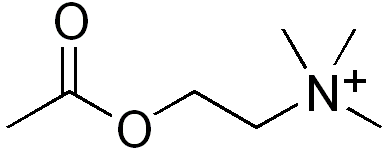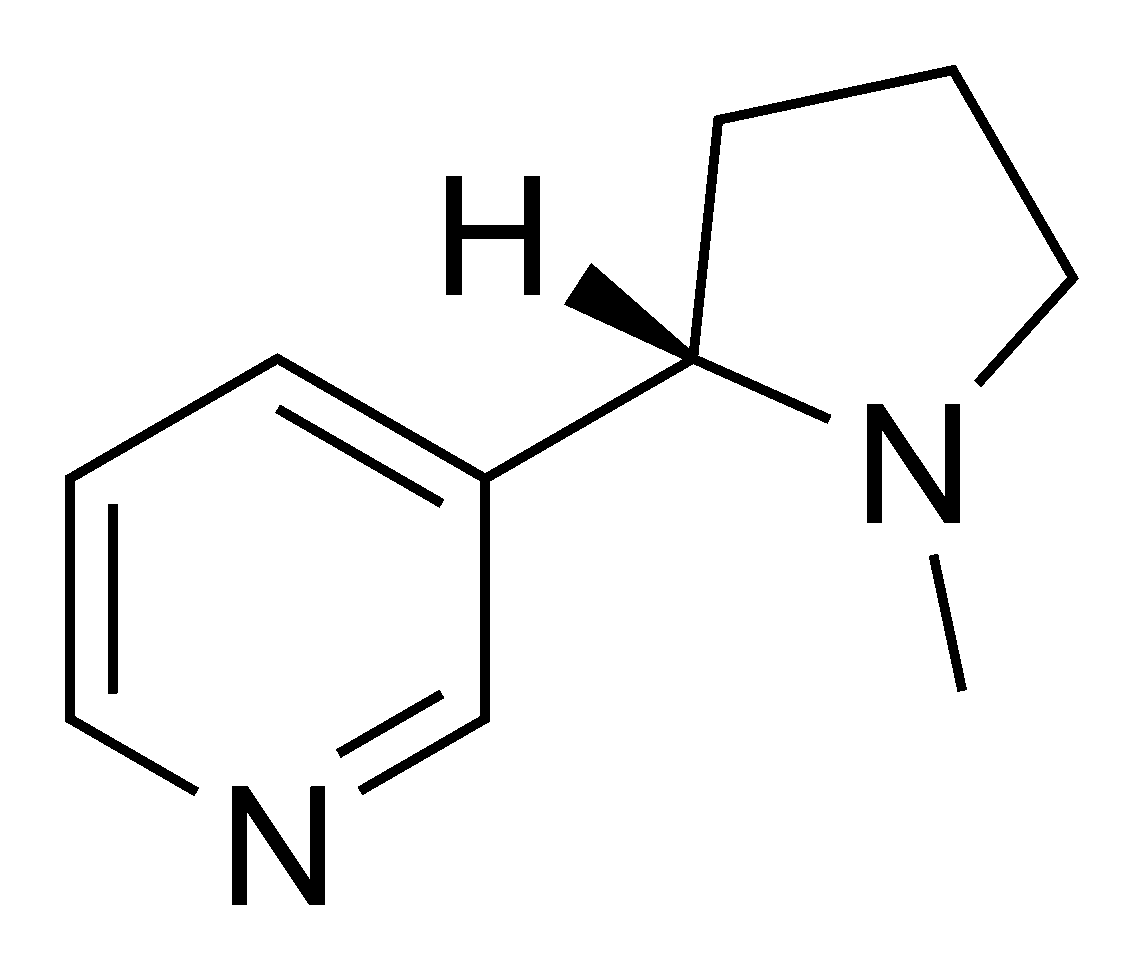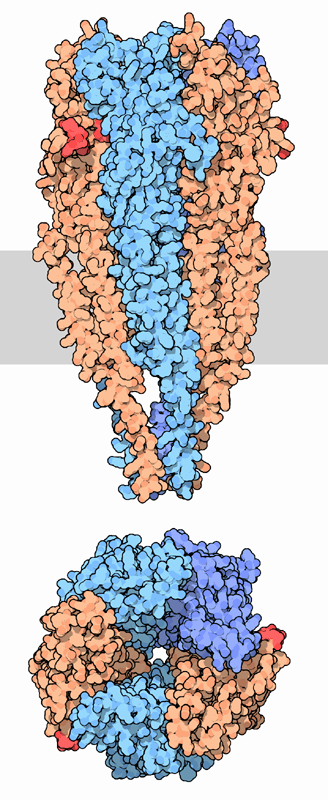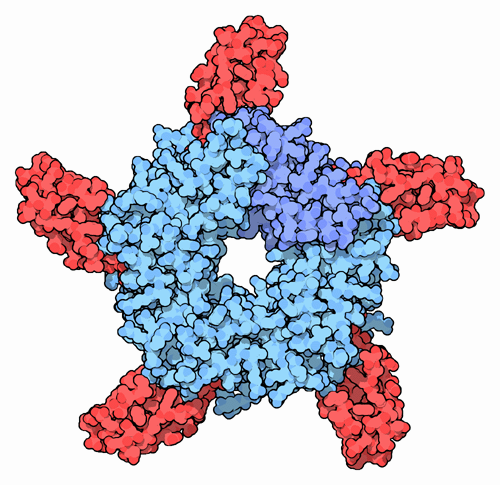Nicotinic acetylcholine receptor
 From Wikidoc - Reading time: 6 min
From Wikidoc - Reading time: 6 min
 |
 |
 |
 |
Editor-In-Chief: C. Michael Gibson, M.S., M.D. [1]
Overview[edit | edit source]
Nicotinic acetylcholine receptors, or nAChRs, are ionotropic receptors that form ligand gated ion channels in cells' plasma membranes. Like the other type of acetylcholine receptors, muscarinic acetylcholine receptors (mAChRs), their opening is triggered by the neurotransmitter acetylcholine (ACh), but they are also opened by nicotine.[1][2] Also in contrast to muscarinic ACh receptors, nicotinic receptors do not operate with a second messenger, but open themselves forming an ion channel. Their action is inhibited by curare.
Nicotinic acetylcholine receptors are present in many tissues in the body. The neuronal receptors are found in the central nervous system and the peripheral nervous system. The neuromuscular receptors are found in the neuromuscular junctions of somatic muscles; stimulation of these receptors causes muscular contraction.
Structure[edit | edit source]
Nicotinic receptors, with a molecular mass of about 280 kDa, are made up of five receptor subunits, arranged symmetrically around the central pore. They share similarities with GABAA receptors, glycine receptors, and the type 3 serotonin receptors, which are all therefore classed into the ionotropic family, or the signature Cys-loop proteins.[3]
Twelve types of nicotinic receptor subunits, α2 through 10 and β2 through 4 (Itier and Bertrand, 2001), combine to form pentamers. The subunits are somewhat similar to one another, especially in the hydrophobic regions.[1] The muscle form of the nAChR consist of two α subunits, a β, a δ and either a γ or an ε.[1][2][4] The neuronal forms are much more heterogeneous, with a wide range of possible subunit combinations.
The sites for binding ACh are on the outside of the α subunits near their N termini.[1]When the agonist binds, the α subunits become more similar to the other subunits, the channel becomes more symmetrical,[5] and a pore with a diameter of about 0.65 nm opens.[1]
Opening the channel[edit | edit source]
Nicotinic AChRs may exist in different interconvertible conformational states. Binding of nicotine stabilizes the open and desensitised states. Opening of the channel allows positively charged ions, in particular, sodium and calcium, to enter the cell.
The nAChR is permeable to Na+ and K+, with some subunit combinations that are also permeable to Ca2+.[1] The amount of sodium and potassium the channels allow through their pores (their conductance) is about 25 pS,[1] but the conductance depends on the actual subunit composition. Interestingly, because some neuronal nAChRs are permeable to Ca2+, they can affect the release of other neurotransmitters.[2] The channel usually opens rapidly and tends to remain open until the agonist diffuses away, usually for about 1 millisecond.[1] However, AChRs can open sometimes with only one agonist bound and in rare cases with no agonist bound, and they can close spontaneously even when ACh is bound, so ACh binding only creates a probability of pore opening, which increases as more ACh binds.[5]
Effects[edit | edit source]
This activation of receptors by nicotine modifies the state of neurons through two main mechanisms. On one hand, the movements of cations cause a depolarization of the plasma membrane, which results in an excitation, particularly of neurons, but also by the activation of other voltage-gated ion channels. On the other hand, the entry of calcium acts, either directly or indirectly, on different intracellular cascades leading, for example, to the regulation of the activity of some genes or the release of neurotransmitters.
Roles[edit | edit source]
The subunits of the nicotinic receptors belong to a multigene family (16 members in human) and the assembly of combinations of subunits results in a large number of different receptors (For more information see the Ligand Gated Ion Channel database). These receptors, with highly variable kinetic, electrophysiological and pharmacological properties, respond differently to nicotine, at very different effective concentrations. This functional diversity allows them to take part in two major types of neurotransmission. Classical synaptic transmission (wiring transmission) involves the release of high concentrations of neurotransmitter, acting on immediately neighbouring receptors. In contrast, paracrine transmission (volume transmission) involves neurotransmitters released by synaptic buttons or varicosities, which then diffuse through the extra-cellular medium until they reach their receptors, which may be distant. Nicotinic receptors can also be found in different synaptic locations, for example the muscle nicotinic receptor always functions post-synaptically. The neuronal forms of the receptor can be found both post-synaptically (involved in classical neurotransmission) and pre-synaptically (where they can influence the release of other neurotranmsitters).
Subunits[edit | edit source]
To date 17 nAChR subunits have been identified, these are divided into muscle-type and neuronal-type subunits. Of these 17 subunits, α2-α7 and β2-β4 have been cloned in humans, the remaining genes identified in chick and rat genomes.[6] The nAChR subunits have been divided into 4 subfamilies (I-IV) based on similarities in protein sequence. In addition, subfamily III has been further divided into 3 tribes.
| Neuronal-type | Muscle-type | ||||
| I | II | III | IV | ||
|---|---|---|---|---|---|
| α9, α10 | α7, α8 | 1 | 2 | 3 | α1, β1, δ, γ, ε |
| α2, α3, α4, α6 | β2, β4 | β3, α5 | |||
- Alpha genes: CHRNA1 (muscle), CHRNA2 (neuronal), CHRNA3, CHRNA4, CHRNA5, CHRNA6, CHRNA7, CHRNA8, CHRNA9, CHRNA10
- Beta genes: CHRNB1 (muscle), CHRNB2 (neuronal), CHRNB3, CHRNB4,
- Other genes: CHRND (delta), CHRNE (epsilon), CHRNG (gamma)
Notable Variations[edit | edit source]
Notable variations[edit | edit source]
Nicotinic receptors are pentamers of these subunits, i.e. each receptor contains five subunits. Thus, there is an immense potential of variation of the aforementioned subunits. However, some of them are more notable than others, specifically (α1)2β1δε (muscle type), (α3)2(β4)3 (ganglion type), (α4)2(β2)3 (CNS type) and (α7)5 (another CNS type).[7] A comparison follows:
| Receptor type | Location | Effect | Nicotinic agonists | Antagonists |
|---|---|---|---|---|
| Muscle type: (α1)2β1δε[7] or α1β1δγε[8] |
Neuromuscular junction | EPSP, mainly by increased Na+ and K+ permeability |
|
|
| Ganglion type: (α1)2(β4)3 |
autonomic ganglia | EPSP, mainly by increased Na+ and K+ permeability |
|
|
| CNS type: (α4)2(β2)3 |
Brain | Post- and presynaptic excitation,[7] mainly by increased Na+ and K+ permeability |
| |
| (another) CNS type: (α7)5 |
Brain | Post- and presynaptic excitation,[7] mainly by increased Ca2+ permeability |
|
|
References[edit | edit source]
- ↑ 1.0 1.1 1.2 1.3 1.4 1.5 1.6 1.7 Siegel G.J., Agranoff B.W., Fisher S.K., Albers R.W., and Uhler M.D. 1999. Basic Neurochemistry: Molecular, Cellular and Medical Aspects, Sixth Edition. GABA Receptor Physiology and Pharmacology. American Society for Neurochemistry. Lippincott Williams and Wilkins. Available.
- ↑ 2.0 2.1 2.2 Itier V. and Bertrand D. 2001. Neuronal nicotinic receptors: from protein structure to function. Edited by Andreas Engel and Giorgio Semenza. FEBS Letters, 504(3), 118-125.
- ↑ Cascio, M. 2004. Structure and function of the glycine receptor and related nicotinicoid receptors. Journal of Biological Chemistry, 279(19), 19383-19386. Available.
- ↑ Giniatullin R., Nistri A., and Yakel J.L. 2005. Desensitization of nicotinic ACh receptors: shaping cholinergic signaling. Trends in Neurosciences, 28(7), 371-378.
- ↑ 5.0 5.1 Colquhoun D. and Sivilotti L.G. 2004. Function and structure in glycine receptors and some of their relatives. Trends in Neurosciences, 27(6), 337-344.
- ↑ Graham A., Court J.A., Martin-Ruiz C.M., Jaros E., Perry R., Volsen S.G., Bose S., Evans N., Ince P., Kuryatov A., Lindstrom J., Gotti C., and Perry E.K. 2002. Immunohistochemical localisation of nicotinic acetylcholine receptor subunits in human cerebellum. Neuroscience, 113(3), 493-507.
- ↑ 7.0 7.1 7.2 7.3 Pharmacology, (Rang, Dale, Ritter & Moore, ISBN 0443071454, 5:th ed., Churchill Livingstone 2003) Page 138.
- ↑ 8.0 8.1 8.2 Neurosci.pharm - MBC 3320 Acetylcholine
External links[edit | edit source]
de:Nikotinischer Acetylcholinrezeptor uk:Нікотиновий ацетилхоліновий рецептор
 KSF
KSF